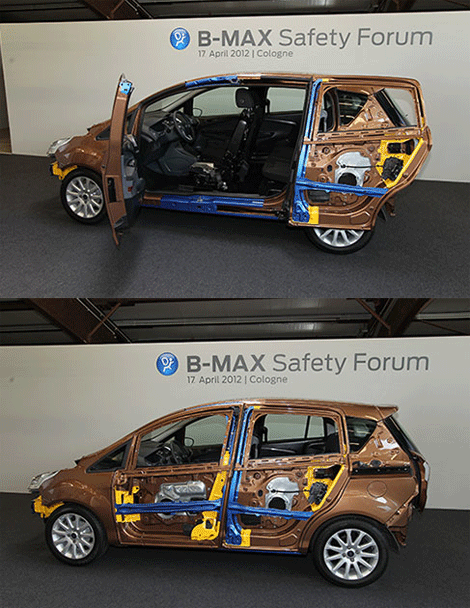
The B-Max survives a battering from a 30mph crash test
Recently we crept away to Germany, to a secretive patch of Ford’s Merkenich test site, into a quiet, compact building, where we were promised we’d see how the manufacturer crash tests its new models.
In the modern age, Finite Element Analysis (FEA) means there’s so much more to it than driving a car into a solid object, but even we were surprised at the extent of the testing – something that European car manufacturers alone spend €20 billion on – and how it fits seamlessly into the full design process.
Integrated into the design are measures for pre- and post-crash, as well as the actual collision, for which the designers of the new Ford B-Max have packed in some brilliant features, especially since the car has no standard B-pillar – the structural beam that during a side on collision you would rely on to save your life – and how it creates an intelligent system to counter this.

The moveable central pillar, highlighted in the blue, has a clever locking system for the occupants’ safety
With standard front doors linking to a pair of sliding rear doors, passenger access is greatly improved for getting in or out, for those that have to reach in and fit child seats, or for getting that large new wardrobe and ton of other purchases back from Ikea without having to hire a van.
To get around the safety issue the design team – made up of so many different micro teams that we lost count – created an intelligent B-pillar: half is contained in the rear section of the front doors, while the other half is in the front section of the sliding rear doors. When the doors are closed it connects with two ‘active’ locks, forming a rigid pillar. More impressive is that if involved in a collision, a third ’emergency’ lock is engaged by the pressure and direction of the side-impact.
Using high strength steel to reinforce the seam and an additional set of horizontal, in-door beams, the structural safety is incredible.
Crashing countless cars is avoided by high level FEA simulation, reducing the time and cost by an incredible amount, repeatedly smashing CAD data models of full car and individual component parts over 5,000 times from every conceivable angle to cover every one of the varying international safety standards.
Physical testing is the final proving ground, in the quiet facility surrounded by a scrapyard of previous test subjects, the design team are desperate to see if their baby can survive the real thing.
At the end of the long runway, garbed in matt panel paint and measurement markings for the laser scanners later on, the B-Max sits under a cradle of lights, surrounded by high-speed cameras to capture the impact for every fraction of a second. We’re stood far closer than expected as a dolly cart – laden with a big metal nose – is propelled by a giant electric dragline down the facility’s runway, powering into the family car at over 30mph and shunting it sideways, crumpling into the bodywork.
You’ll be pleased to hear that the family of occupants were left unscathed, with the adult, child and baby dummies being saved by a combination of rigid structure and instantly deployed side airbags.
There’s more on this in next month’s edition of the magazine. If you’ve yet to subscribe for your own free copy of the magazine you can do so here.

The long run down the crash test track, with the B-Max waiting at the end






